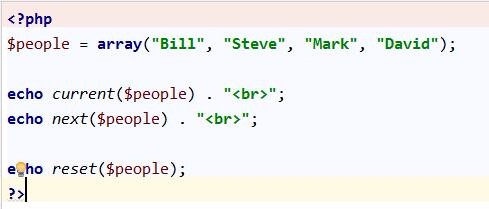10 recommended articles about next()
The following editor will bring you a summary and detailed comparison of several methods of Java collection traversal. The editor thinks it’s pretty good, so I’ll share it with you now and give it as a reference. Let’s follow the editor to take a look at the general traversal method of collection classes, using iterators to iterate: Iterator it = list.iterator();
while(it.hasNext()) {
Object obj = it.next();
}Map traversal method: 1. Traverse by getting all keys //Set
1. 10 recommended articles about next()

Introduction: The following editor will bring you a summary and detailed comparison of several methods of java collection traversal. The editor thinks it’s pretty good, so I’ll share it with you now and give it as a reference. Let’s follow the editor to take a look at the general traversal method of collection classes, using iterators to iterate: Iterator it = list.iterator();while(it.hasNext()) { Object obj = ;it.ne...
2. 10 recommended content for next()

Introduction: The following editor will bring you a summary and detailed comparison of several methods of java collection traversal. The editor thinks it’s pretty good, so I’ll share it with you now and give it as a reference. Let’s follow the editor to take a look at the general traversal method of collection classes, using iterators to iterate: Iterator it = list.iterator();while(it.hasNext()) { Object obj = ;it.ne...
3. Detailed introduction to next()

Introduction: The following editor will bring you a summary and detailed comparison of several methods of Java collection traversal. The editor thinks it’s pretty good, so I’ll share it with you now and give it as a reference. Let’s follow the editor to take a look at the general traversal method of collection classes, using iterators to iterate: Iterator it = list.iterator();while(it.hasNext()) { Object obj = ;it.ne...
4. 10 recommended articles about traversal methods

Introduction: The following editor will bring you a summary and detailed comparison of several methods of java collection traversal. The editor thinks it’s pretty good, so I’ll share it with you now and give it as a reference. Let’s follow the editor to take a look at the general traversal method of collection classes, using iterators to iterate: Iterator it = list.iterator();while(it.hasNext()) { Object obj = ;it.ne...
5. 10 recommended articles about php next() function

Introduction: The user has multiple business cards and needs to switch left and right to view them. Switching down is the menu button. Here we need to slide in two places. We use the sliding component swiper provided by WeChat and use it in a nested manner. The first layer is the up and down sliding of the business card display and the menu button. The second layer is the left and right sliding of the business card display (supports mutual embedding. It can be used as a set, so you can use it with confidence). Vertical Adding it means sliding vertically, removing it means sliding left and right. The overall structure is as follows: The click event is bound to the data switching method because it needs to support multiple click switching. The initialization data is nextSli...
6. php operation array functions current, next and reset function usage examples

Introduction: The current() function in PHP returns the current element in the array (unit, which is the first element of the array, next() The function points the internal pointer to the next element in the array and outputs the value of the element. The reset() function points the internal pointer to the first element in the array and outputs the value of the element. This article mainly introduces it. Usage of current, next and reset functions in PHP. It describes in detail the specific usage of functions current, next and reset for array operations in PHP in the form of examples. It has certain reference value for in-depth understanding of the usage of arrays. I hope it will help everyone understand arrays. Help
7. Python iterator and itertools module

Introduction: In python, the iterator protocol is to implement the __iter() method and next() method of the object, where the former returns the object itself and the latter returns the next element of the container. These two methods are implemented. The object is an iterable object. Iterators are lazy and are only generated when used. This provides benefits for processing large amounts of data. Instead of writing all the data into memory at once, I wrote an iterator myself. You can see that you can use the for loop to process iterators written by yourself, objects that implement the iterator protocol, and you can use any iterator tool similar to the for loop. However, look at the output below, the second output is empty. Why? When we use list, we can output the same one multiple times
##8. Detailed explanation of the use of jQuery's next() function

##. #9.
php array php array function sequence next - moves the internal pointer of the array to the position of the next element and returns the element valueIntroduction: php array: php array php array function sequence next - moves the internal pointer of the array to the position of the next element and returns the value of the element: next() Definition and Usage The next() function moves the pointer to the current element. to the next element and returns the value of that element. If the internal pointer has exceeded the last element of the array, the function returns false. Syntax next(array) Parameter Description array Required Description next() and current() behaves similarly, with one difference: it moves the internal pointer forward one bit before returning the value. This means that it returns the value of the next array element and moves it
##. #10. php array function sequence next() - moves the internal pointer of the array to the position of the next element and returns the value of the element_PHP Tutorial
Introduction : PHP array function sequence next() - moves the internal pointer of the array to the position of the next element and returns the element value. next() Definition and Usage The next() function moves the pointer to the current element to the position of the next element and returns the value of that element. If the internal pointer has exceeded the last element of the array
[Related Q&A recommendation]:
javascript - Generator.prototype.throw() How does it work?
javascript - Using vue-router's beforeEach hook, next('/') reports an error
javascript - Array.keys related issues
Python3 interactive mode next(file) file.tell() OSError recovery problem?
golang - go-sql-driver/mysql for rows.Next() performance issues
The above is the detailed content of 10 recommended articles about next(). For more information, please follow other related articles on the PHP Chinese website!

Hot AI Tools

Undresser.AI Undress
AI-powered app for creating realistic nude photos

AI Clothes Remover
Online AI tool for removing clothes from photos.

Undress AI Tool
Undress images for free

Clothoff.io
AI clothes remover

Video Face Swap
Swap faces in any video effortlessly with our completely free AI face swap tool!

Hot Article

Hot Tools

Notepad++7.3.1
Easy-to-use and free code editor

SublimeText3 Chinese version
Chinese version, very easy to use

Zend Studio 13.0.1
Powerful PHP integrated development environment

Dreamweaver CS6
Visual web development tools

SublimeText3 Mac version
God-level code editing software (SublimeText3)

Hot Topics
 PHP 8.4 Installation and Upgrade guide for Ubuntu and Debian
Dec 24, 2024 pm 04:42 PM
PHP 8.4 Installation and Upgrade guide for Ubuntu and Debian
Dec 24, 2024 pm 04:42 PM
PHP 8.4 brings several new features, security improvements, and performance improvements with healthy amounts of feature deprecations and removals. This guide explains how to install PHP 8.4 or upgrade to PHP 8.4 on Ubuntu, Debian, or their derivati
 7 PHP Functions I Regret I Didn't Know Before
Nov 13, 2024 am 09:42 AM
7 PHP Functions I Regret I Didn't Know Before
Nov 13, 2024 am 09:42 AM
If you are an experienced PHP developer, you might have the feeling that you’ve been there and done that already.You have developed a significant number of applications, debugged millions of lines of code, and tweaked a bunch of scripts to achieve op
 How To Set Up Visual Studio Code (VS Code) for PHP Development
Dec 20, 2024 am 11:31 AM
How To Set Up Visual Studio Code (VS Code) for PHP Development
Dec 20, 2024 am 11:31 AM
Visual Studio Code, also known as VS Code, is a free source code editor — or integrated development environment (IDE) — available for all major operating systems. With a large collection of extensions for many programming languages, VS Code can be c
 Explain JSON Web Tokens (JWT) and their use case in PHP APIs.
Apr 05, 2025 am 12:04 AM
Explain JSON Web Tokens (JWT) and their use case in PHP APIs.
Apr 05, 2025 am 12:04 AM
JWT is an open standard based on JSON, used to securely transmit information between parties, mainly for identity authentication and information exchange. 1. JWT consists of three parts: Header, Payload and Signature. 2. The working principle of JWT includes three steps: generating JWT, verifying JWT and parsing Payload. 3. When using JWT for authentication in PHP, JWT can be generated and verified, and user role and permission information can be included in advanced usage. 4. Common errors include signature verification failure, token expiration, and payload oversized. Debugging skills include using debugging tools and logging. 5. Performance optimization and best practices include using appropriate signature algorithms, setting validity periods reasonably,
 PHP Program to Count Vowels in a String
Feb 07, 2025 pm 12:12 PM
PHP Program to Count Vowels in a String
Feb 07, 2025 pm 12:12 PM
A string is a sequence of characters, including letters, numbers, and symbols. This tutorial will learn how to calculate the number of vowels in a given string in PHP using different methods. The vowels in English are a, e, i, o, u, and they can be uppercase or lowercase. What is a vowel? Vowels are alphabetic characters that represent a specific pronunciation. There are five vowels in English, including uppercase and lowercase: a, e, i, o, u Example 1 Input: String = "Tutorialspoint" Output: 6 explain The vowels in the string "Tutorialspoint" are u, o, i, a, o, i. There are 6 yuan in total
 How do you parse and process HTML/XML in PHP?
Feb 07, 2025 am 11:57 AM
How do you parse and process HTML/XML in PHP?
Feb 07, 2025 am 11:57 AM
This tutorial demonstrates how to efficiently process XML documents using PHP. XML (eXtensible Markup Language) is a versatile text-based markup language designed for both human readability and machine parsing. It's commonly used for data storage an
 Explain late static binding in PHP (static::).
Apr 03, 2025 am 12:04 AM
Explain late static binding in PHP (static::).
Apr 03, 2025 am 12:04 AM
Static binding (static::) implements late static binding (LSB) in PHP, allowing calling classes to be referenced in static contexts rather than defining classes. 1) The parsing process is performed at runtime, 2) Look up the call class in the inheritance relationship, 3) It may bring performance overhead.
 What are PHP magic methods (__construct, __destruct, __call, __get, __set, etc.) and provide use cases?
Apr 03, 2025 am 12:03 AM
What are PHP magic methods (__construct, __destruct, __call, __get, __set, etc.) and provide use cases?
Apr 03, 2025 am 12:03 AM
What are the magic methods of PHP? PHP's magic methods include: 1.\_\_construct, used to initialize objects; 2.\_\_destruct, used to clean up resources; 3.\_\_call, handle non-existent method calls; 4.\_\_get, implement dynamic attribute access; 5.\_\_set, implement dynamic attribute settings. These methods are automatically called in certain situations, improving code flexibility and efficiency.






